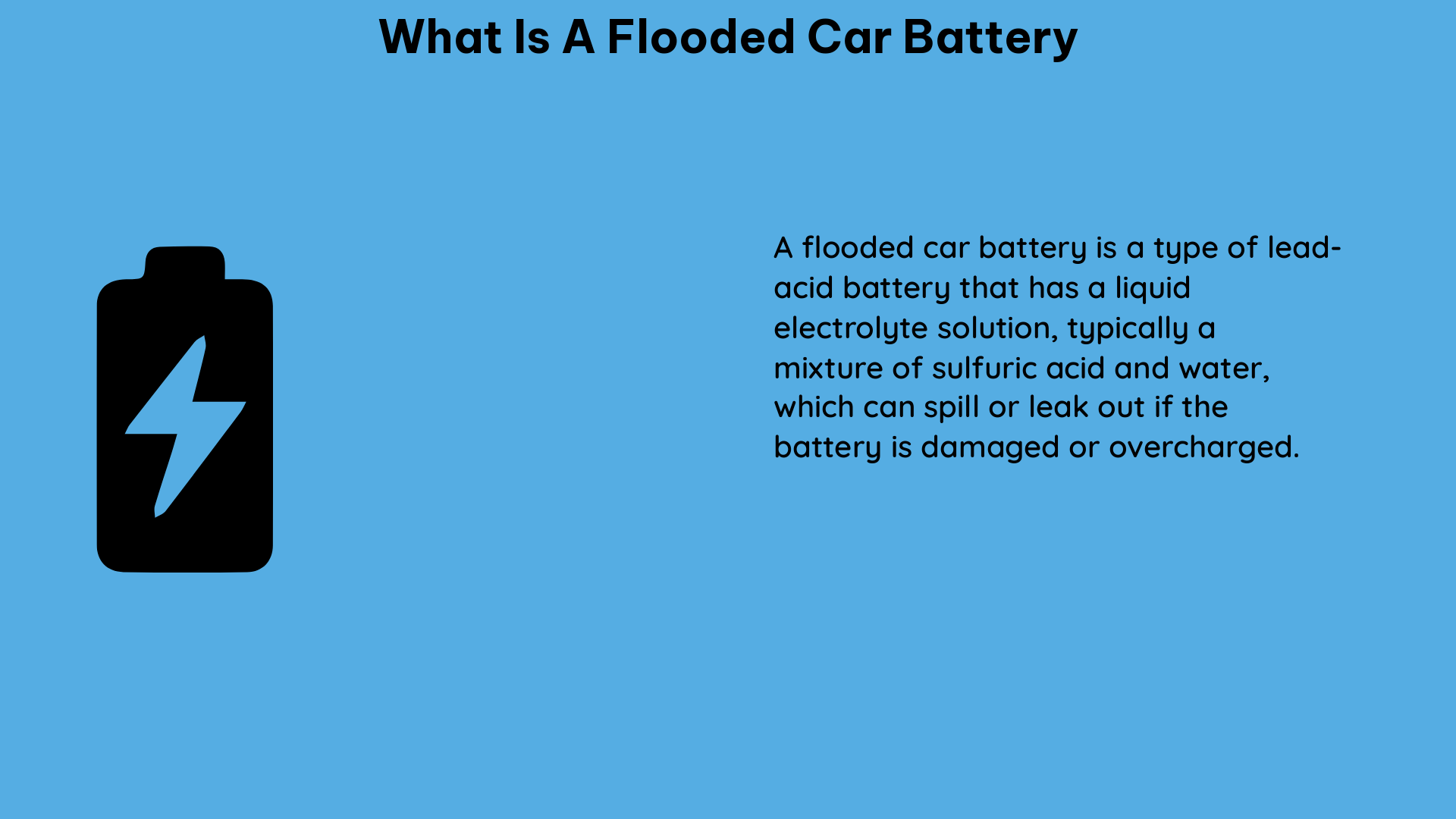A flooded car battery, also known as a wet cell battery, is a type of lead-acid battery that contains a liquid electrolyte solution. The plates inside the battery are submerged in this liquid, which consists of sulfuric acid and water. As the battery discharges, the acid in the electrolyte reacts with the lead plates, creating lead sulfate and releasing electrical energy. When the battery is recharged, this process is reversed, and the lead sulfate is converted back into lead and sulfuric acid.
Understanding the Anatomy of a Flooded Car Battery
A flooded car battery is composed of several key components:
-
Lead Plates: The positive and negative plates inside the battery are made of lead. These plates are responsible for the electrochemical reactions that generate and store electrical energy.
-
Electrolyte Solution: The liquid electrolyte solution is a mixture of sulfuric acid and water. This solution surrounds the lead plates and facilitates the flow of ions during the charging and discharging process.
-
Separator: The separator is a porous material that physically separates the positive and negative plates, preventing them from coming into direct contact and causing a short circuit.
-
Container: The battery’s container is typically made of a durable plastic material that can withstand the corrosive nature of the electrolyte solution.
-
Vents: Flooded batteries are not sealed, and they have vents that allow the release of gases (hydrogen and oxygen) generated during the charging and discharging process.
Key Characteristics of Flooded Car Batteries

Flooded car batteries have several distinct characteristics that set them apart from other types of lead-acid batteries, such as AGM (Absorbent Glass Mat) or gel batteries:
-
Maintenance Requirements: Flooded batteries require regular maintenance, including checking and topping up the electrolyte levels with distilled water. This is necessary because the electrolyte can evaporate over time, especially in hot climates or during high-temperature charging.
-
Venting Capabilities: Flooded batteries are not sealed, which means they can vent gases during charging and discharging. This can lead to the emission of hazardous gases, such as hydrogen and oxygen, which can be potentially explosive if they accumulate in a confined space.
-
Energy Density: Flooded batteries have a lower energy density than AGM or gel batteries, which means they are typically larger and heavier for a given amount of electrical energy storage.
-
Cost: Flooded batteries are generally less expensive than AGM or gel batteries, making them a popular choice for many applications where cost is a significant factor.
Technical Specifications of Flooded Car Batteries
Flooded car batteries are typically rated based on the following technical specifications:
-
Cold Cranking Amps (CCA): This measure the battery’s ability to deliver a high current burst in cold temperatures, which is crucial for starting the engine in cold weather conditions. A typical flooded car battery may have a CCA rating ranging from 300 to 800 amps, depending on the vehicle’s power requirements.
-
Reserve Capacity (RC): This measure how long the battery can deliver a minimum current at a given temperature, typically 25 amps at 80°F (26.7°C). The reserve capacity of a flooded car battery can range from 40 to 120 minutes, depending on the battery’s size and design.
-
Amp-Hour (Ah) Rating: This measure the total amount of electrical charge the battery can deliver over a specific time period, typically 20 hours. Flooded car batteries typically have Ah ratings ranging from 40 to 100 Ah, depending on the vehicle’s power demands.
-
Voltage: Flooded car batteries are typically 12-volt systems, with each individual cell producing approximately 2.1 volts.
DIY Maintenance for Flooded Car Batteries
Proper maintenance is crucial for ensuring the longevity and optimal performance of a flooded car battery. Here are some key DIY maintenance tasks:
-
Electrolyte Level Checking and Topping Up: Regularly check the electrolyte level in each cell of the battery and top up with distilled water as needed. Avoid overfilling, as this can dilute the electrolyte solution.
-
Terminal Cleaning and Corrosion Removal: Keep the battery terminals clean and free of corrosion, as this can affect the battery’s performance and lifespan. Use a wire brush or baking soda and water solution to clean the terminals.
-
Equalization Charging: Periodically, perform an equalization charge to prevent stratification of the electrolyte and ensure that the plates are evenly charged. This process involves charging the battery at a slightly higher voltage for a specific duration.
-
Proper Storage and Charging: When the vehicle is not in use, store the flooded battery in a cool, dry place and keep it fully charged. Avoid leaving the battery in a discharged state, as this can lead to sulfation and reduced capacity.
By understanding the characteristics and maintenance requirements of flooded car batteries, you can ensure that your vehicle’s power source remains reliable and efficient, even in the most demanding driving conditions.
References:
- The Differences Between AGM, Gel, and Flooded Batteries
- Flooded Batteries vs. AGM Batteries: Understanding the Differences
- AGM vs. Flooded Batteries: What You Need to Know
- Understanding Lead-Acid Battery Types: Flooded, AGM, and Gel
- Flooded Lead-Acid Battery Maintenance

The lambdageeks.com Core SME Team is a group of experienced subject matter experts from diverse scientific and technical fields including Physics, Chemistry, Technology,Electronics & Electrical Engineering, Automotive, Mechanical Engineering. Our team collaborates to create high-quality, well-researched articles on a wide range of science and technology topics for the lambdageeks.com website.
All Our Senior SME are having more than 7 Years of experience in the respective fields . They are either Working Industry Professionals or assocaited With different Universities. Refer Our Authors Page to get to know About our Core SMEs.